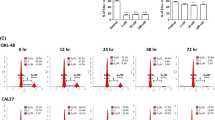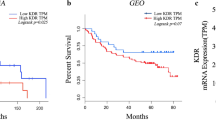Abstract
Aflibercept and arsenic trioxide drugs apply a cytotoxic effect on some human cancer cell lines. However, no more study has followed the effects of both drugs, especially arsenic trioxide, on oral squamous cell carcinoma (OCC). We used three OCC lines as a model to show the effect of these drugs on the genetically complex disease and investigate its targeted therapy. In this study, three human OCC cell lines were used from different patients. We treated cell lines with both medications to detect the effect and relevant molecular basis. First, methyl thiazolyl tetrazolium (MTT) assay was performed to detect the cytotoxicity effect and cell growth. Second, flow cytometry, gene and protein expression were performed to evaluate the anti-angiogenic effect on OCC lines. Next apoptosis was analyzed by flow cytometry. Finally, clonogenesis capacity and cell migration were assessed by colony formation assay and wound healing, respectively. Aflibercept had no cytotoxic effect on the three OCC cell lines but decreased cell growth rate. Arsenic trioxide had a significant cytotoxic effect on three cell lines. Our results demonstrated that both drugs significantly decreased endoglin, VEGFA, and VEGFB expression. In addition, Migration and colony formation assays confirmed that these drugs have significant anti-proliferative and anti-migration effect on oral carcinoma cells. These results revealed that both medications might be a potential drug for the management of oral cancer patients.







Similar content being viewed by others
Data availability
The datasets used and/or analyzed during the current study are available from the corresponding author on reasonable request.
References
Tandon P, Dadhich A, Saluja H, Bawane S, Sachdeva S (2017) The prevalence of squamous cell carcinoma in different sites of oral cavity at our Rural Health Care Centre in Loni, Maharashtra–a retrospective 10-year study. Contemp Oncol 21:178
Markopoulos A (2012) Current aspects on oral squamous cell carcinoma. Open Dent. J 6:126–130
Ferlay J, Soerjomataram I, Dikshit R, Eser S, Mathers C, Rebelo M, Parkin DM, Forman D, Bray F (2015) Cancer incidence and mortality worldwide: sources, methods and major patterns in GLOBOCAN 2012. Int J Cancer 136:E359–E386
Ausoni S, Boscolo-Rizzo P, Singh B, da Mosto MC, Spinato G, Tirelli G, Spinato R, Azzarello G (2016) Targeting cellular and molecular drivers of head and neck squamous cell carcinoma: current options and emerging perspectives. Cancer Metastasis Rev 35:413–426
Zheng D, Ye T, Hu H, Zhang Y, Sun Y, Xiang J, Chen H (2018) Upfront surgery as first-line therapy in selected patients with stage IIIA non–small cell lung cancer. J Thorac Cardiovasc Surg 155(1814–1822):e4
Pulte D, Brenner H (2010) Changes in survival in head and neck cancers in the late 20th and early 21st century: a period analysis. Oncologist 15:994
Gong W, Xiao Y, Wei Z, Yuan Y, Qiu M, Sun C, Zeng X, Liang X, Feng M, Chen Q (2017) Toward the use of precision medicine for the treatment of head and neck squamous cell carcinoma. Oncotarget 8:2141
Teleanu RI, Chircov C, Grumezescu AM, Teleanu DM (2020) Tumor angiogenesis and anti-angiogenic strategies for cancer treatment. J Clin Med 9:84
Auvray M, Tougeron D, Auclin E, Moulin V, Artru P, Hautefeuille V, Hammel P, Lecomte T, Locher C, Sickersen G (2019) Efficacy and safety of aflibercept in combination with chemotherapy beyond second-line therapy in metastatic colorectal carcinoma patients: an AGEO multicenter study. Clin Colorectal Cancer.
Ganjibakhsh M, Monshizadeh R, Nasimian A, Aminishakib P, Farzaneh P, Shiraji S, Gharajei A, Rahrotaban S, Baghaei F, Gohari NS (2018) Anti-angiogenic efficacy of aflibercept and bevacizumab in primary oral squamous cell carcinoma cells. J Oral Pathol Med 47:575–582
Nasr R (2010) Eradication of acute promyelocytic leukemia-initiating cells by PML/RARA-targeting. Int J Hematol 91:742–747
Baysan A, Yel L, Gollapudi S, Su H, Gupta S (2007) Arsenic trioxide induces apoptosis via the mitochondrial pathway by upregulating the expression of Bax and Bim in human B cells. Int J Oncol 30:313–318
Ganjibakhsh M, Aminishakib P, Farzaneh P, Karimi A, Fazeli SAS, Rajabi M, Nasimian A, Naini FB, Rahmati H, Gohari NS (2017) Establishment and characterization of primary cultures from Iranian oral squamous cell carcinoma patients by enzymatic method and explant culture. J Dent (Tehran, Iran) 14:191
Sheikholeslami K, Sher A, Lockman S, Kroft D, Ganjibakhsh M, Nejati-Koshki K, Shojaei S, Ghavami S, Rastegar M (2019) Simvastatin induces apoptosis in medulloblastoma brain tumor cells via mevalonate cascade prenylation substrates. Cancers 11:994
Franken NA, Rodermond HM, Stap J, Haveman J, van Bree C (2006) Clonogenic assay of cells in vitro. Nat Protoc 1:2315–2319
Venter C, Niesler C (2019) Rapid quantification of cellular proliferation and migration using ImageJ. Biotechniques 66:99–102
Ganjibakhsh M, Mehraein F, Koruji M, Aflatoonian R, Farzaneh P (2019) Three-dimensional decellularized amnion membrane scaffold promotes the efficiency of male germ cells generation from human induced pluripotent stem cells. Exp Cell Res 384:111544
Park WH, Cho YH, Jung CW, Park JO, Kim K, Im YH, Lee MH, Kang WK, Park K (2003) Arsenic trioxide inhibits the growth of A498 renal cell carcinoma cells via cell cycle arrest or apoptosis. Biochem Biophys Res Commun 300:230–235
Bonner JA, Harari PM, Giralt J, Cohen RB, Jones CU, Sur RK, Raben D, Baselga J, Spencer SA, Zhu J (2010) Radiotherapy plus cetuximab for locoregionally advanced head and neck cancer: 5-year survival data from a phase 3 randomised trial, and relation between cetuximab-induced rash and survival. Lancet Oncol 11:21–28
Riley RD, Ensor J, Snell KI, Debray TP, Altman DG, Moons KG, Collins GS (2016) External validation of clinical prediction models using big datasets from e-health records or IPD meta-analysis: opportunities and challenges. BMJ 353:i3140
Rodríguez-Remírez M, Del Puerto-Nevado L, Aceñero MJF, Ebrahimi-Nik H, Cruz-Ramos M, García-García L, Solanes S, Baños N, Molina-Roldán E, García-Foncillas J (2020) Strong antitumor activity of bevacizumab and aflibercept in neuroendocrine carcinomas: in-depth preclinical study. Neuroendocrinology 110:50–62
Miller WH, Schipper HM, Lee JS, Singer J, Waxman S (2002) Mechanisms of action of arsenic trioxide. Can Res 62:3893–3903
Kuivenhoven M, Mason K (2019) Arsenic (Arsine) toxicity. StatPearls. StatPearls Publishing.
Druker BJ, Guilhot F, O’Brien SG, Gathmann I, Kantarjian H, Gattermann N, Deininger MW, Silver RT, Goldman JM, Stone RM (2006) Five-year follow-up of patients receiving imatinib for chronic myeloid leukemia. N Engl J Med 355:2408–2417
Fisher R, Pusztai L, Swanton C (2013) Cancer heterogeneity: implications for targeted therapeutics. Br J Cancer 108:479–485
van Cutsem E, Kohne C-H, Láng I, Folprecht G, Nowacki MP, Cascinu S, Shchepotin I, Maurel J, Cunningham D, Tejpar S (2011) Cetuximab plus irinotecan, fluorouracil, and leucovorin as first-line treatment for metastatic colorectal cancer: updated analysis of overall survival according to tumor KRAS and BRAF mutation status. J Clin Oncol 29:2011–2019
Network CGA (2015) Comprehensive genomic characterization of head and neck squamous cell carcinomas. Nature 517:576–582
Kumar P, Gao Q, Ning Y, Wang Z, Krebsbach PH, Polverini PJ (2008) Arsenic trioxide enhances the therapeutic efficacy of radiation treatment of oral squamous carcinoma while protecting bone. Mol Cancer Ther 7:2060–2069
Hicklin DJ, Ellis LM (2005) Role of the vascular endothelial growth factor pathway in tumor growth and angiogenesis. J Clin Oncol 23:1011–1027
Kian MM, Mohammadi S, Tavallaei M, Chahardouli B, Rostami S, Zahedpanah M, Ghavamzadeh A, Nikbakht M (2018) Inhibitory effects of arsenic trioxide and thalidomide on angiogenesis and vascular endothelial growth factor expression in leukemia cells. Asian Pac J Cancer Prev 19:1127
Mărgăritescu C, Simionescu C, Mogoantă L, Badea P, Pirici D, Stepan A, Ciurea R (2008) Endoglin (CD105) and microvessel density in oral squamous cell carcinoma. Rom J Morphol Embryol 49:321–326
Giuliani J, Bonetti A (2016) The development of hypertension in metastatic colorectal cancer patients treated with aflibercept: the role of systolic and diastolic blood pressure before starting treatment. Recent Prog Med 107:199–200
Mawardi H, Enzinger P, McCleary N, Manon R, Villa A, Treister N, Woo S-B (2016) Osteonecrosis of the jaw associated with ziv-aflibercept. J Gastroint Oncol 7:E81
Cai X, Yu Y, Huang Y, Zhang L, Jia P, Zhao Q, Chen Z, Tong J, Dai W, Chen G (2003) Arsenic trioxide-induced mitotic arrest and apoptosis in acute promyelocytic leukemia cells. Leukemia 17:1333–1337
Chen YC, Lin-Shiau SY, Lin JK (1998) Involvement of reactive oxygen species and caspase 3 activation in arsenite-induced apoptosis. J Cell Physiol 177:324–333
Nakaoka T, Ota A, Ono T, Karnan S, Konishi H, Furuhashi A, Ohmura Y, Yamada Y, Hosokawa Y, Kazaoka Y (2014) Combined arsenic trioxide-cisplatin treatment enhances apoptosis in oral squamous cell carcinoma cells. Cell Oncol 37:119–129
Liu M-H, Fu W-J, Cui Y-H, Guo Q-N, Zhou Y (2016) Downregulation of Semaphorin-3F is associated with poor prognostic significance in osteosarcoma patients. Am J Cancer Res 6:2252
Zandberg DP, Tallon LJ, Nagaraj S, Sadzewicz LK, Zhang Y, Strome MB, Zhao XE, Vavikolanu K, Zhang X, Papadimitriou JC (2019) Intratumor genetic heterogeneity in squamous cell carcinoma of the oral cavity. Head Neck 41:2514–2524
Zhong L, Liu Y, Wang K, He Z, Gong Z, Zhao Z, Yang Y, Gao X, Li F, Wu H (2018) Biomarkers: paving stones on the road towards the personalized precision medicine for oral squamous cell carcinoma. BMC Cancer 18:911
Montero PH, Patel SG (2015) Cancer of the oral cavity. Surg Oncol Clin 24:491–508
Naruse T, Yanamoto S, Matsushita Y, Sakamoto Y, Morishita K, Ohba S, Shiraishi T, Yamada SI, Asahina I, Umeda M (2016) Cetuximab for the treatment of locally advanced and recurrent/metastatic oral cancer: an investigation of distant metastasis. Mol Clin Oncol 5:246–252
Acknowledgements
This study was financially supported by the Craniomaxillofacial Research Center, Tehran University of Medical Sciences. Also, it was supported by the Iranian Biological Resource Center, Academic Center for Education, Culture, and Research.
Funding
This study was supported by University of Tehran (Grant Number 97-03-69-39794)
Author information
Authors and Affiliations
Contributions
Study conception and design: SD, MA, MG, PF. Acquisition of data: MA, FP, SR, STS, MG. Analysis and interpretation of data: MA, MG, STS. Drafting of manuscript: SD, MA, PA, PF. Critical revision: PA, FP, SR, PF.
Corresponding author
Ethics declarations
Conflict of interest
The authors declare no conflict of interests.
Consent to participate
Written informed consent was obtained from each subject or his or her legal representative before inclusion into the study.
Ethical approval
The ethical committee of Tehran University approved this study (IR.TUMS.DENTISTRY.REC.1397.146).
Additional information
Publisher's Note
Springer Nature remains neutral with regard to jurisdictional claims in published maps and institutional affiliations.
Supplementary Information
Below is the link to the electronic supplementary material.
11033_2021_6341_MOESM1_ESM.tif
Figure S1. Two methods were employed to ensure no contamination of cells in this study. (A) PCR analysis of mycoplasma contamination showed no contamination in cells. (B) DNA staining with Hoechst. OCC-11, OCC-18, and OCC-20 showed no contamination. Supplementary file1 (TIF 1722 kb)
11033_2021_6341_MOESM2_ESM.tif
Figure S2. Short tandem repeat (STR) profile of established OCC cell lines: (A) OCC-11, (B) OCC-18, (C) OCC-20. Supplementary file2 (TIF 498 kb)
Rights and permissions
About this article
Cite this article
Derakhshan, S., Aminishakib, P., Pirzadeh, F. et al. The effect of aflibercept and arsenic trioxide on the proliferation, migration and apoptosis of oral squamous cell carcinoma in vitro. Mol Biol Rep 48, 3223–3235 (2021). https://doi.org/10.1007/s11033-021-06341-w
Received:
Accepted:
Published:
Issue Date:
DOI: https://doi.org/10.1007/s11033-021-06341-w




